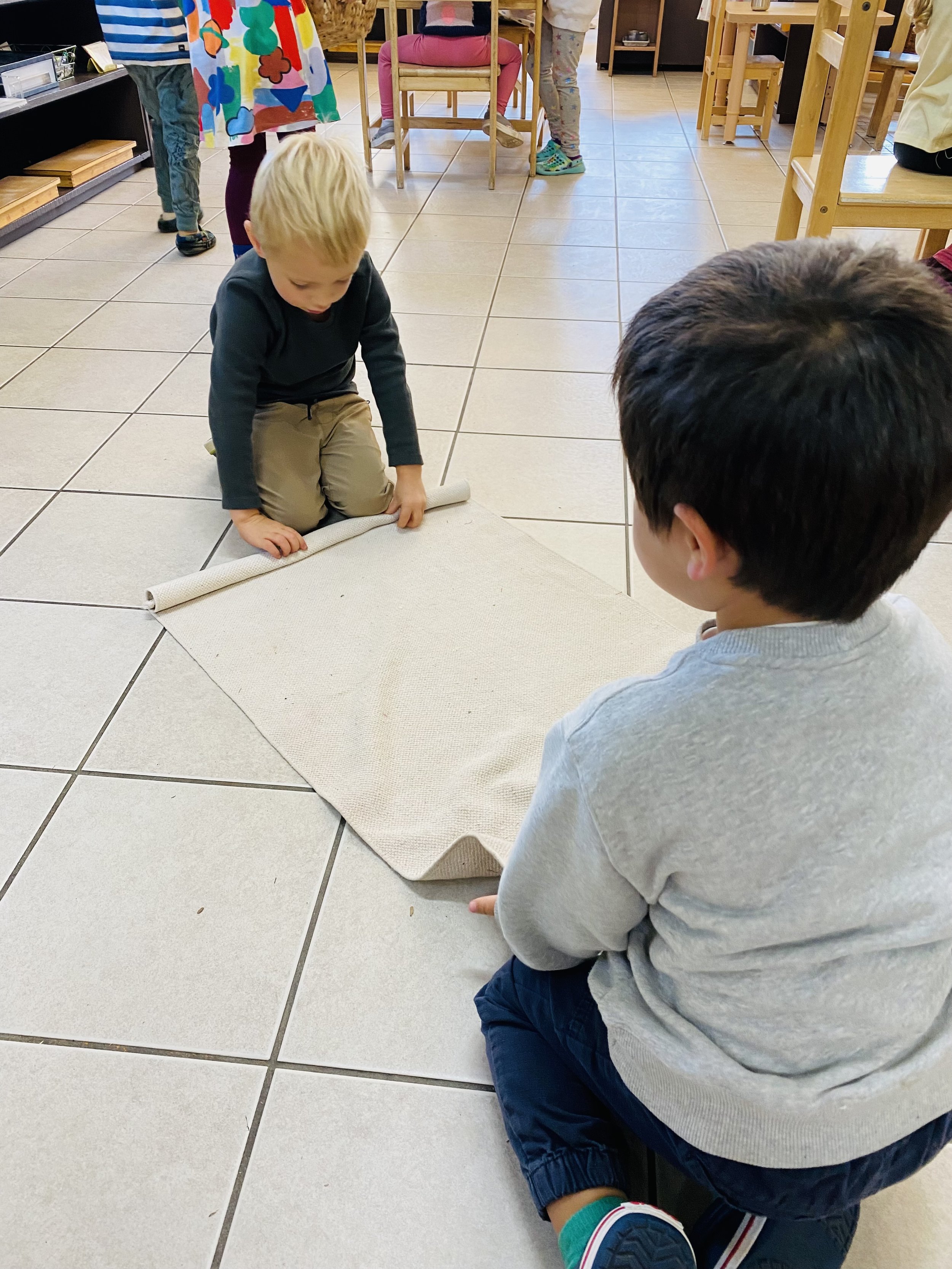Social & Emotional Development
by Regan Becker
“Preventing conflicts is the work of politics; establishing peace is the work of education.”— Dr. Maria Montessori, Education and Peace
Montessori education is a child-centered approach that emphasizes the development of the whole child – intellectually, spiritually, physically, socially, and emotionally. Montessori education emphasizes the importance of empathy in children, as it is a critical component of social-emotional learning. Empathy is the ability to understand and share the feelings of others, and it is essential for building positive relationships with others.
Social-emotional learning (SEL) is a process of developing skills that help children manage their emotions, set and achieve goals, develop positive relationships, and make responsible decisions. SEL is a lifelong process that is essential for success in all areas of life.
The Center for Disease Control (CDC) offers a comprehensive checklist of milestones for young children. Lighthouse Montessori School enrolls children from ages two and a half through six. For these ages, here are some guideposts for your child’s social and emotional development at each year:
At two and a half years old, a child may be able to:
Play or learn next to other children at a separate task (aka “parallel play”)
Follow simple routines or directions with fewer than three steps
Answer in word or action when asked a process question, such as “What do we do with our long sleeves before we wash our hands?” (Roll or push them up)
Families and caregivers may assist the two and a half year old child’s social and emotional development by:
Giving freedom of choice within limits (no more than three options)
Modeling how to share and take turns with one another
Encouraging free play with other children at a park or playground
Providing consistency by eating meals together
Demonstrating being socially and emotionally present by interacting without the use of media, which makes the viewer child an object instead of a subject
Assisting a child’s social skills by conversing more and asking questions that start with “who?” and “what?”
Spending time in nature so that a child becomes familiar and at ease with being outdoors and adjusting to weather changes
At three years old, a child may be able to:
Self-regulate after separating from a parent or caregiver within ten minutes
Notice others playing or learning and join them
Families and caregivers may assist the three year old child’s social and emotional development by:
Naming feelings when they arise, such as “I feel sad” or asking “You seem frustrated. Are you feeling frustrated right now?” Feelings are okay and should never be shut down.
Asking the child questions to help understand and address a problem through use of Grace and Courtesy actions, such as: taking turns, sharing, naming their feelings, and asking for help
Showing how to self-regulate by: taking deep breaths, drinking water, eating a little snack, asking for a hug or hugging a stuffed animal, and (voluntarily) finding a quiet space to calm down
Practicing agreements and consequences at home (as opposed to rules and punishments or rewards), such as: “In our house, we use gentle hands for loving.” Children (and adults!) require many opportunities to practice social and emotional problem-solving. When we make mistakes, we learn through those errors. It is never okay to shame a child or make them feel like they have failed. Always a lesson, never a failure.
Modeling accountability and responsibility by apologizing when you as an adult make a mistake. Children appreciate seeing adults work through their own social and emotional development. Share (brief) stories about times you have made mistakes and taken responsibility for repairing relationships.
Assisting your child’s social skills by conversing more and asking questions that start with “when?” (answers contain before and after, not actual times) and “where?”
Asking the child to help you. Helping an adult feels like connection and trust to a child. Name “chores” as “helping works” to emphasize the social value in them, such as: washing fruit and vegetables or stirring. These are akin to the Practical Life materials in the Montessori classroom.
At four years old, a child may be able to:
Pretend during play, and distinguish between real and imaginary objects
Think and plan about playing or learning with other children who are not present, such as: “Where is Samara today?” or “I want to invite Theo to the playground.”
Comfort others and show empathy, such as helping someone pick up spilled grains or offering a hand to hold when someone is crying
Change their behavior depending on the place and show hesitancy in unfamiliar settings
Families and caregivers may assist the four year old child’s social and emotional development by:
Previewing new experiences or transitions, such as through role play or “rehearsing”
Noticing when the child engages in negative social behavior, such as: grabbing, hitting, or calling names (“He’s a bad guy!”). Interrupt negative social behavior by modeling how to replace physical aggression with words, such as: “Don’t touch my hair!” or “May I have a turn next?” Separate the child from the action, so that children learn that people make mistakes and are learning.
Modeling empathy for others, such as “You look like you feel sad. Do you feel sad? What can I do to help you? Would you like a hug?”
Respecting bodily consent — even within family dynamics, such as asking “May I help you with your coat, or can you do it?” and honoring the child’s response.
Appreciate the child’s positive words and behaviors (without use of rewards and punishments), and avoid saying “no” or “don’t” — unless there is a safety concern. Tell the child what you want them to do, not what you don’t want. This aligns with the Positive Discipline training we adults practice, both staff and families. What we give attention to, grows.
Cultivate a calm and quiet bedtime routine. Avoid media two hours prior to bath time or cozy time. Children this age require 10-13 hours of sleep per day, including naps.
At five years old, a child may be able to:
Take turns and share with others
Help at home with folding clean laundry or picking up their toys
Demonstrate their burgeoning independence by “talking back” to see the consequences of their words and actions. The five year old child still needs loving and firm boundaries to feel safe making choices, even if they are errors.
Families and caregivers may assist the five year old child’s social and emotional development by:
Assisting your child’s social skills by conversing more and asking questions that start with “why?” and “how?”
Constructing things with the child, such as a fort made from wooden building blocks or an outfit made of scarves
Giving the child lessons on self-care, such as: how to comb your hair, how to button your shirt, how to pour water from a pitcher to a glass. These are akin to the Practical Life materials in the Montessori classroom, such as the grooming tray or the dressing frames. Process is more important than product. The aim is growth, not perfection.
Naming feelings of characters in stories you read to the child, such as asking, “how can you tell what Clifford is feeling? What feeling does his face show?”
If you play board games, practice following the rules of the game and having fun. Children can become frustrated when they do not win. If competition is embedded in the game, practice saying “good game” or “it’s okay, try again.” Play a variety of games and activities, not all of which are competitive in structure.
Montessori classrooms provide many opportunities for children to develop empathy. Children in Montessori classrooms often work together in mixed-age groups, which provides opportunities for younger children to learn from older children and vice versa. Through these interactions, children can learn to understand and appreciate others’ perspectives and differences in ability.
Montessori classrooms encourage active listening and acknowledging the feelings of others, even (or especially) when there is disagreement. This helps children develop positive relationships based on mutual respect and understanding, not just sameness of experience and belief. Around the age of two and a half or three, children enter a Casa dei Bambini or Children’s House. Dr. Montessori told students in a 1946 Montessori teacher-training course that children “need the society of other children at this age.”
In Montessori primary classrooms, children come to prefer “real” utensils to toys. While working with objects such as real brushes for washing tables and real brooms to sweep, children attain real skills that allow them to participate more fully in life, both at home and at school. They are trusted to carry objects made of glass, even if the objects might break, because they are training their bodies and minds to be careful and thoughtful. These Practical Life materials instill in children that they are real helpers and real members of the learning community. This is, after all, the Children’s House.
Emotionally, the 3-6 child is still rather self-centered – in the best sense of the word. At the same time, they are learning how to be with others socially and emotionally outside of the comfort of home and their relationship with family and caregivers. Transitioning to Montessori school with its new adults and new peers (of different ages and abilities) helps the primary age child to adapt and empathize with other settings and personalities. When children work purposefully, they increase their independence and come to realize that their actions benefit others.
The exercises of Grace and Courtesy are pro-social behaviors that help children control their bodies and move more gracefully, while giving them the courtesy of social life – the modeled (not commanded) “please” and “thank you” that denotes manners. Dr. Montessori observed that by age three, children respond with gratitude, trust, and respect for those who are willing to help them orient themselves in their world. They evolve a sense of worth, security, and emotional expression, along with autonomy and independence. When children are able to concentrate, doubt and timidity disappear. Children become calmer – what Dr. Montessori termed “normalized” in their outlook and behavior.
"If a person were to grow up with a healthy soul, enjoying the full development of a strong character and a clear intellect, they could not endure to uphold two kinds of justice – the one protecting life and the other destroying it. Nor would they consent to cultivate in their heart both love and hate.” – Dr. Maria Montessori








